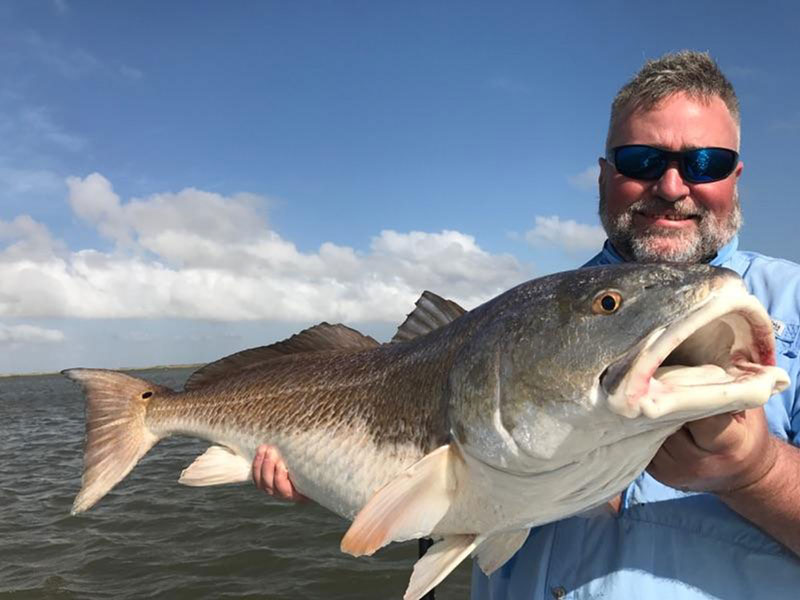Red drum, also known as redfish, are one of the top targets of many anglers when they go fishing on the Chesapeake Bay.

What Are Redfish?
Red Drum, or as know scientifically Sciaenops ocellatus, is a near-shore species that, when young, are adaptable to a range of habitats, temperatures, and salinity. Common names for them include red drum, redfish, reds, red bass, spot tail, channel bass, puppy drum (when small), and bull red (when large). When young, reds can live in many habitats such as estuaries or river mouths, around seagrass beds, oyster bottoms, and more. They have also been known to travel into freshwater areas, as well as areas of very high salinity. While young red drum are very adaptable, but as they grow into adults the conditions they require become less flexible. As adults, redfish tend to live in open coastal waters with salinity ranging from 30 to 35 parts per thousand, and temperatures ranging from 39 to 93 degrees. These fish have been known to live up to over 50 years and with their unusual growth patterns which are rapid when young but are much slower over age five, a 36-inch redfish could be anywhere from six to 50 years old. From late summer to early fall, red drum are spawning and at night, often near tidal-inlets, and on occasion people can hear their drumming/purring sound.
Here is a list of the basic characteristics of Red Fish:
- Copper reddish coloring
- The ventral side is a lighter color or almost white
- Distinctive black spot near the base of the tail
- Blunt snout
- Caudal fin is slight concaved
- Arched back
- Sloping head
The main predator of red drum are humans. Osprey and other birds of prey will eat them, especially when small, but humans are considered to be their main threat.
Not only are red drum they great sportfish, but they are considered excellent food-fish and are raised for food by aquaculture operations in some states. Just like another one of our top five Chesapeake sport fish, the speckled sea trout, redfish make purring or drumming noises that comes from their swim bladders, like other fish in the drum family.

Record Red Drum
Let’s check out the state records for redfish:
Delaware – 75 pounds, caught by James Vandetti in 1977
Maryland – 74 pounds, six ounces, caught by Earnest Hutchinson, also in 1977
Virginia – 85 pounds, four ounces, caught by Herman Moore in 1981
Notice anything unusual? All of these records were set decades ago. And they’ll likely never be broken, because red drum regulations in all of these states have a “slot limit.” That means you can only keep fish within a certain size range, such as between 18 and 26 inches (the exact measurements vary by state). Larger fish must be released to protect the stock. As a result, anglers can’t keep those very large fish that might top record red drum and set new records for redfish.
Where and When to catch Redfish
Red drum are the most abundant in the Gulf of Mexico but can be found from Mexico to Cape Cod, all along the Atlantic Coast. However, they are less and less common north of New Jersey. Fortunately for those of us in Chesapeake country, adult reds can be found in the Bay from April or May through November, usually in waters above 15 or so parts per thousand. Young reds are seen farther up the Bay, and large adult bull redfish are often found near the mouth of the Bay through much of the season. For a short window of time during mid-summer they may also be found by lucky anglers in Middle Bay areas from the Patuxent River down to near the Virginia/Maryland state line in deep water, sometimes under breaking fish of other species. Read Chesapeake Bay Bull Redfish, to learn more about this fishery in specific.
Many anglers also like to fish for red drum at night, along shoals near the mouth of the Bay. Here’s a list of areas near shoals that are often nighttime hotspots near the mouth of the Bay:
- Along the CBBT
- Inner Middle Ground
- Latimer Shoals
- Off Fisherman’s Island
How to catch Redfish
In the Chesapeake Bay anglers may use either lure of baits to fish for redfish. Lures are the most common offering when fishing in the shallows, including many of the techniques outlined in Redfish Fishing: Fall in Puppy Love. Lures are also often used for jigging for fall redfish. The lures commonly used by redfish anglers include:
- Plugs
- Bucktails
- Spoons
- Soft plastic jigs
Baits are commonly used to catch redfish in the Chesapeake Bay and along the Mid-Atlantic coast as well, especially at night or when fishing in the surf. Popular choices include:
- Soft or peeler Crab
- Menhaden
- Spot
- Clam
- Mullet
- Shrimp
Even with slot limits in place and releasing large fish a must, bull redfish remain an incredibly popular target for anglers in the Chesapeake Bay and Mid-Atlantic region. And considering how exciting landing one of these big fish can be, it’s no wonder why.
-By Maya Rogalski